"When once you have tasted flight, you will forever walk the earth with your eyes turned skyward, for there you have been, and there you will always long to return." - Leonardo da Vinci
"I think a future flight should include a poet, a priest and a philosopher . . we might get a much better idea of what we saw." - Astronaut Michael Collins
"In March 1962, James Webb, Administrator of the National Aeronautics and Space Administration, suggested that artists be enlisted to document the historic effort to send the first human beings to the moon. John Walker, director of the National Gallery of Art, was among those who applauded the idea, urging that artists be encouraged "…not only to record the physical appearance of the strange new world which space technology is creating, but to edit, select and probe for the inner meaning and emotional impact of events which may change the destiny of our race."
[From the Eyewitness to Space Collection at the Smithsonian National Air and Space Museum]
All drawings are © the respective artist or their assignee(s)
- The original web image files have been cropped to remove excess white space from around the borders, but no changes have been made to the artworks themselves.
- n.d. = no date
- Conté crayons are composed of compressed powdered graphite or charcoal mixed with a wax or clay base and are square in cross-section ^.
- A serigraph is a colour print made by adapting the silk-screen process^.

Rocket Rollout
(oil on canvas) n.d. by Jack Perlmutter [obit.]
"Rocket Rollout, also titled Moon, Horizon and Flowers. An abstract representation of moving the Saturn rocket from the Vehicle Assembly Building to the launch pad."
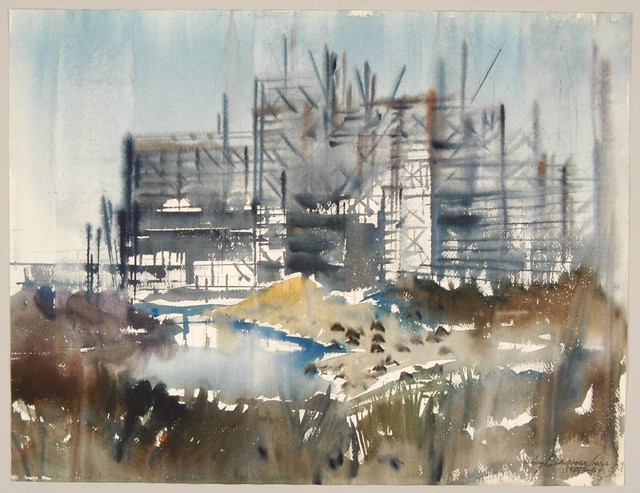
Unfinished Monster
(watercolour on paper) 1964 by Hugh Laidman [books]
"The construction of the Vehicle Assembly Building occupies almost half of the pictorial space. It is done in dark blue, blurry lines against a light blue sky with some accents of black and brown. The water in the middleground is a more vivid blue, and the field in the foreground is a blend of many colors with some white spaces showing through."
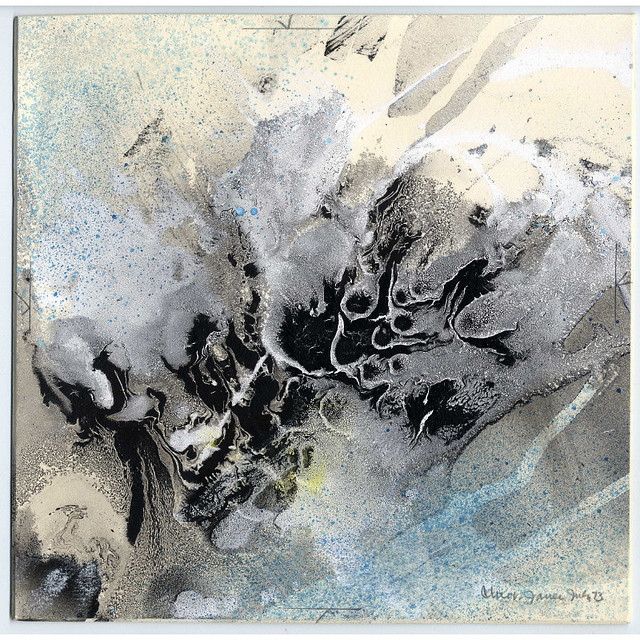
Skyforms-F
(watercolour + mixed media on board) 1973 by Albert Christ-Janer
"Skyforms F, July '73; from Series A-M. Forms reminiscent of an explosion. Organic black forms visually interacting with each other. Black forms enmeshed with grayed areas. Smoke-like forms, blue speckled atmosphere in top left hand corner as well as bottom right hand corner."
Scholarly research awards in the name of both Christ-Janer (d. 1973) and another artist from the NASA group, Lamar Dodd (see below), are given out each year by the University of Georgia.

Untitled
(conté crayon on paper) 1968 by Tom O'Hara
"Three technicians in front of "train wreck", 10/9/68."
+n.d.+by+James+Wyeth.jpg)
Firing Room
(acrylic painting on paper) n.d. by James Wyeth
"A view from the back of the firing room, which is headquarters for Launch Control at the Kennedy Space Center. Rows of consoles and people seated facing them extend from the foreground to the middleground, occupying half of the space. Five light blue monitors are on the wall above the consoles, and three clocks are above them. An illuminated exit sign is in the empty dark space on the right."
[W]: "From 1966 to 1971, Wyeth served in the Delaware Air National Guard. Although at one point scheduled for immediate deployment to Vietnam, flights were cancelled for noncombatants. His assignment changed when he was granted top-security clearance and took part in “Eyewitness to Space”, a program jointly sponsored by NASA and the National Gallery of Art in Washington to depict the activities of the Apollo mission through an artists' perspective. A total of 47 artists were involved in the "Eyewitness to Space" program, including Robert Rauschenberg, Lamar Dodd, Norman Rockwell, and Morris Graves. Participants met astronauts at launch sites, such as Cape Kennedy, or rode helicopters to observe the pickup of astronauts. Of the works developed, National Gallery of Arts chose 70 paintings, sculptures or drawings for "The Artist and Space" exhibit that ran from December 1969 to early January, 1970"

Untitled
(felt-tip pen on paper) 1965 by Robert T McCall
{USS Lake Champlain, recovery carrier}
"Gemini spacecraft after recovery, 8/29/65"
+n.d.+by+Alfred+Hennen+McAdams.jpg)
Untitled
(felt-tip pen on paper) n.d. by Alfred Hennen McAdams
The Artwork of Alfred McAdams [bio]
+n.d.+by+Jim+Mahoney+Jr.jpg)
Untitled
(charcoal on paper) n.d. by Jim Mahoney Jr
"[D]etailed view of a crawler transporter with the huge tread takes up more than half of the image. The edge of a second tread is visible beyond the one in the foreground. The body of the crawler rises on the left side of the scene. The paper is tan colored."
Creating NASA's Gentle Giants via the NASA Mission Pages.
The video below [Inside a NASA Crawler Transporter (~17 mins)] "is a guided tour [..] given by KSC's Crawler Transporter manager, back in 2000. We go throughout the interior and up on the top where the Mobile Launch platform for Apollo Saturn V and later the Space Shuttle stacks are mounted and taken out to the launch pad." [via]

Untitled
(conté crayon on paper) 1968 by Tom O'Hara
"Apollo 7, First Stage, 10/10/68. The bottom section of the first stage of Apollo 7 fills the scene and conveys its tremendous size in comparison to the workers below. Four diagonal supports lean against the rocket, and the letters "S" and "A" can be seen in the upper left. Comprehensive shading and strong horizontal and vertical lines add detail and texture to the depiction."
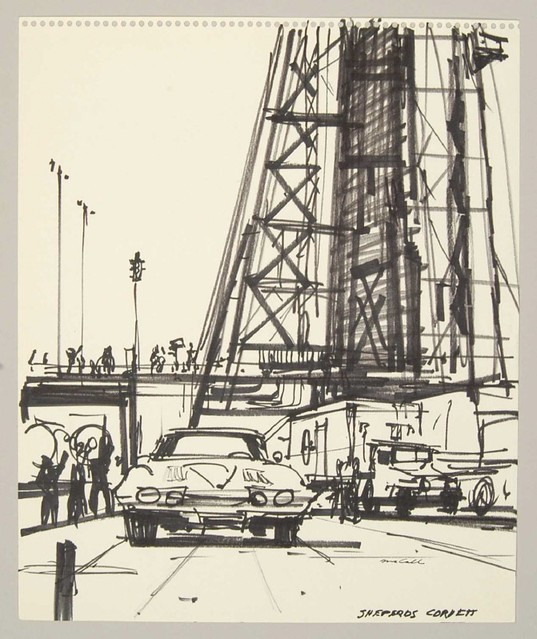
Shepard's Corvette
(felt-tip pen on paper) n.d. by Robert T McCall
"Shepard's Corvette. The front of a Corvette is shown in the foreground and two larger vehicles are parked to the right and back of it. The gantry in the background on the right is shown from the bottom up and the center is a heavily darkened vertical column. The forms of people are abstracted to a few lines on the catwalk in the left center of the scene."
How astronauts and corvettes became associated :-
"Navy pilot Alan Shepard, one of the original "Mercury Seven^," was on his second Corvette, a '57, when he joined the space program in April, 1959. Shepard loved fast cars, and his affinity for Corvette (he'd also owned a '53) didn't go unnoticed by Chief Engineer Zora Arkus-Duntov. Duntov even brought Shepard to Detroit to test-drive pre-production models. Despite the status and celebrity of the new astronauts, the idea of giving any of them a Corvette was anathema to The General. Sometime after Shepard's first suborbital flight, GM President Ed Cole decided that Shepard should receive a Corvette, which he did--a '62, with a deluxe Bill Mitchell interior." [...more]
[also] {pics of the gift-car from a 2010 exhibit} (NASA's Shepard bio/obit)
+1963+by+Lamar+Dodd.jpg)
Untitled
(charcoal on paper) 1963 by Lamar Dodd
"Gantry and Service Tower, '63. The entirety of the gantry and service tower are drawn in a somewhat simplified way. The forms are blurred by the soft shading of charcoal, and shading also defines the sky."
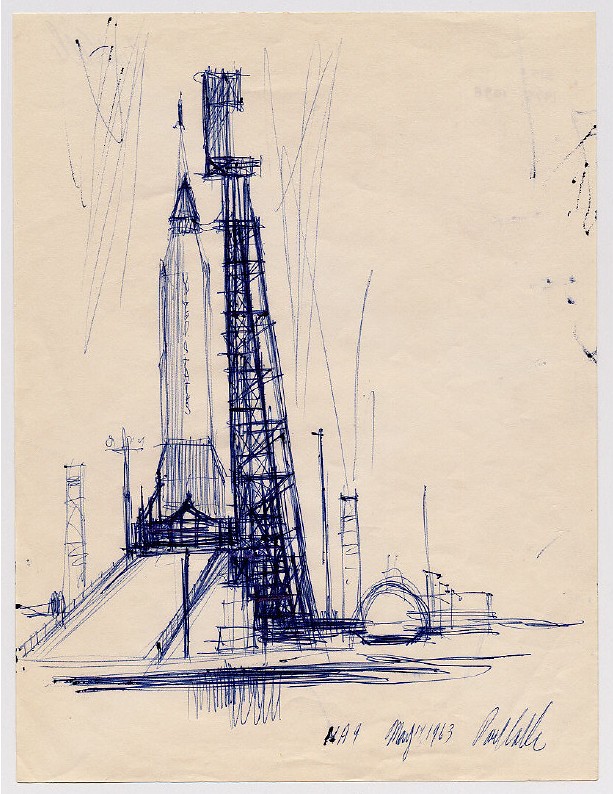
Rocket and Gantry
(ball point pen on paper) 1963 by Paul Calle
"Rocket and Gantry, May 14, 1963. A sketch in blue ball point pen of the side view of a rocket and gantry. The rocket is on the left and the gantry is on the right. Sketch lines fill in some of the space on the sides and beneath. Ink scribbles and blots in the upper right."
Paul Calle (d.2010) designed the stamp that commemorated the first moon landing in 1969. [NYTimes obit.]

Ladders
(acrylic painting on canvas) 1964 by Mitchell Jamieson
"The Saturn I launch pad has the look of a stained-glass window with its mosaic-like patches of lines and brilliant color. On the left and right are the massive frameworks of the red gantries. In the center is the more neutral colored rocket with tiny people at the base. The background is a dark blue sky with specks of white."

Saturn-Apollo Rollout
(gouache on paper) n.d. by Robert T McCall
"Saturn/Apollo rollout is moved out of the Vehicle Assembly Building."
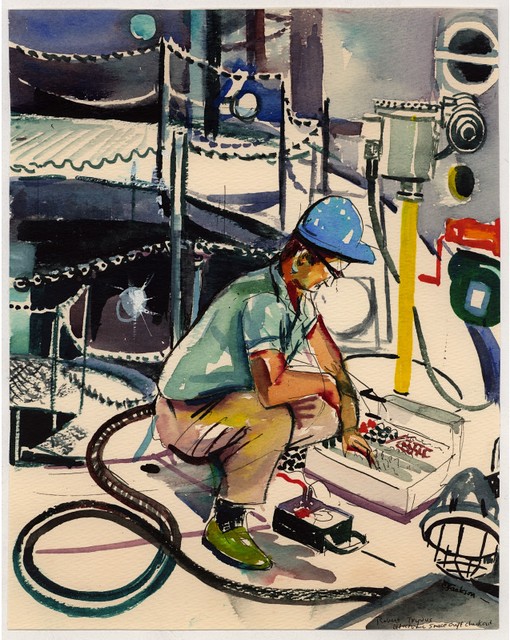
Nic space checkout (?)
(ink + watercolour on paper) n.d. by Chrystal Jackson
Artist homesite biography & kids books || 'Missouri Artist Recalls Alien Encounters'
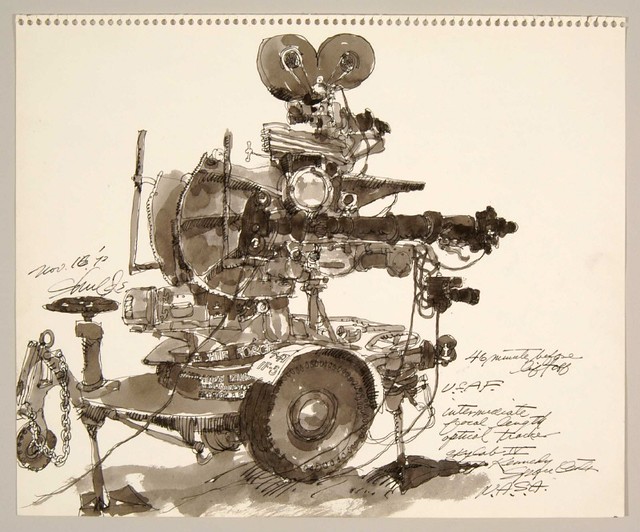
Intermediate Focal Length
(pen, ink + ink wash on paper) 1973 by William Shields
"The optical tracker on a wheeled trailer looks like a big gray mouse pointing at something on right. The tracker is full of visual detail and is shaded with a dark wash. No background is shown. Writing in the lower right says: '46 minutes before liftoff U.S.A.F. intermediate focal length optical tracker Skylab IV Cape Kennedy Space Center N.A.S.A.' "
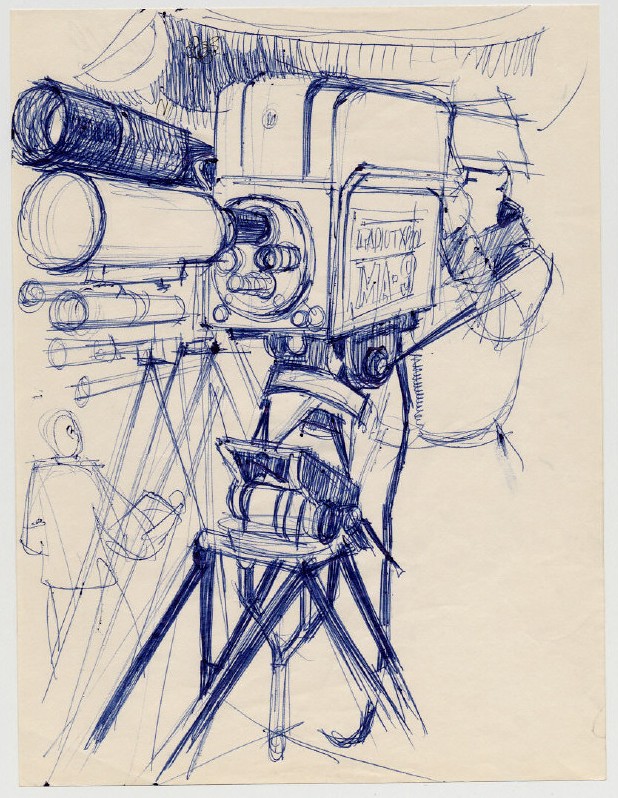
TV Camera and Cameraman
(ball point pen on paper) 1963 by Paul Calle
"A full page sketch in blue ball point pen of a camera on a complex tripod in the center of the page. The camera lens is pointed to the left and the label on the right says "RADIOTXPOOL MA-9." The cameraman is standing on the right looking into the camera and his left arm is raised. Another figure is outlined in the lower left."

Untitled
(pen, ink + watercolour on paper) n.d. by Chrystal Jackson
"The dish, mission control headquarters"

Untitled
(pen + ink on paper) n.d. [NASA worker] by Joseph Christopher Chizanskos
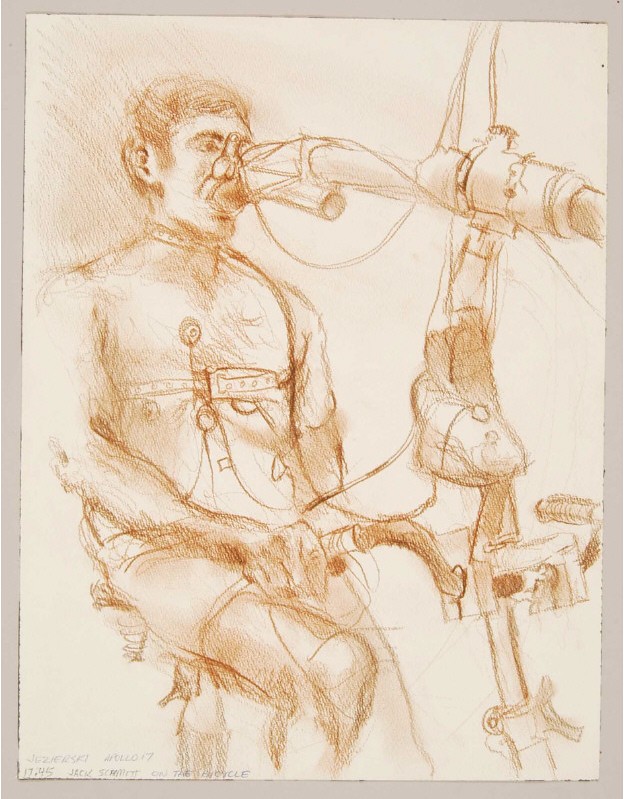
Jack Schmitt on the Bicycle
(conté crayon on paper) n.d. by Chet Jezierski
"Astronaut Jack Schmitt^ is seen from the knees up, seated on a bicycle. The respiratory checking system extends horizontally from his mouth to the right edge. His right hand rests on the handlebars. Some background shading is in the upper left. Writing in the lower left reads: 'Apollo 17 17:45 Jack Schmitt on the Bicycle.' "
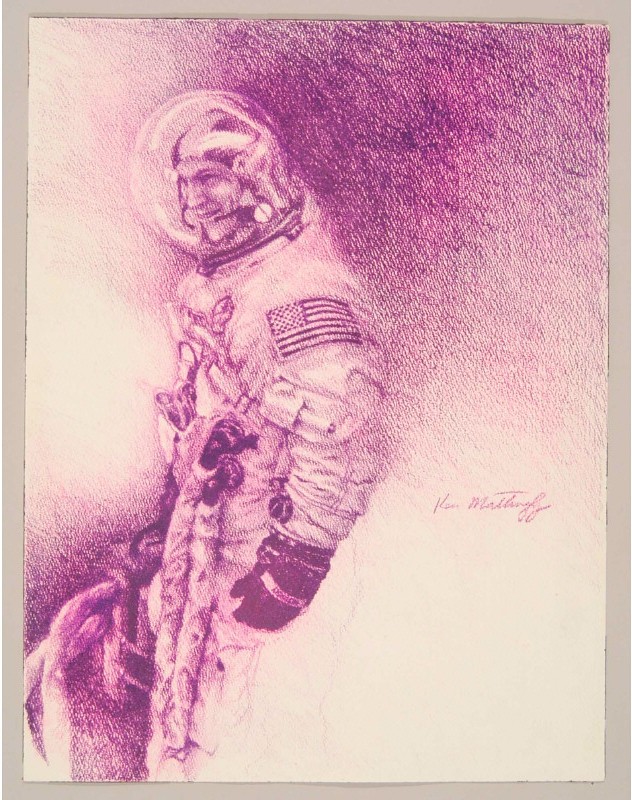
Astronaut Thomas K. Mattingly II
(pencil on paper) 1972 by Chet Jezierski
"The piece is a very realistic drawing of astronaut Ken Mattingly of Apollo 16. It is entirely done in purple and has a somewhat grainy texture. Mattingly is standing in his spacesuit and helmet, facing left, and holding some equipment in his right hand. The shading is darker nearer the subject in the upper right and lower left. The upper left and lower right areas are blank, and the drawing ends at Mattingly's knees. In the blank space on the right is Mattingly's signature."

Moon Walker
(serigraph) n.d. by Mitchell Jamieson
"A linear figure in a spacesuit is partially obscured by a spotty and streaked texture as well as areas that are shadowed with ink."
Jamieson was one of the earliest recruits to NASA's Fine Arts Program, which had begun in 1962. In the following year, he spent 2 weeks on a carrier in the mid-Pacific waiting to document the return of Astronaut Gordon Cooper from one of the last missions of Project Mercury^, a 4-year long effort to achieve manned space flight. Jamieson had also been a volunteer artist during the Vietnam war and the psychic toll probably contributed to his taking his own life in 1976.
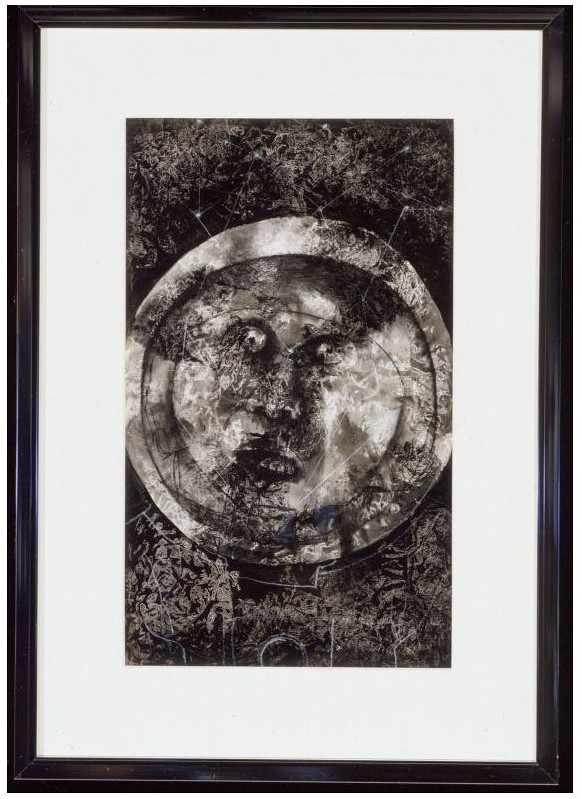
First Look
(ink + chalk on paper) n.d. by Mitchell Jamieson
"An abstract representation of the head and shoulders of an astronaut. The eyes, nose, and mouth of the astronaut are discernible within the circular helmet. The three divisions of the space at the top, the head, and the shoulders are detailed with marble-like patterns. Straight white lines connect small white dots across the top two-thirds of the piece, reminiscent of constellations of stars."
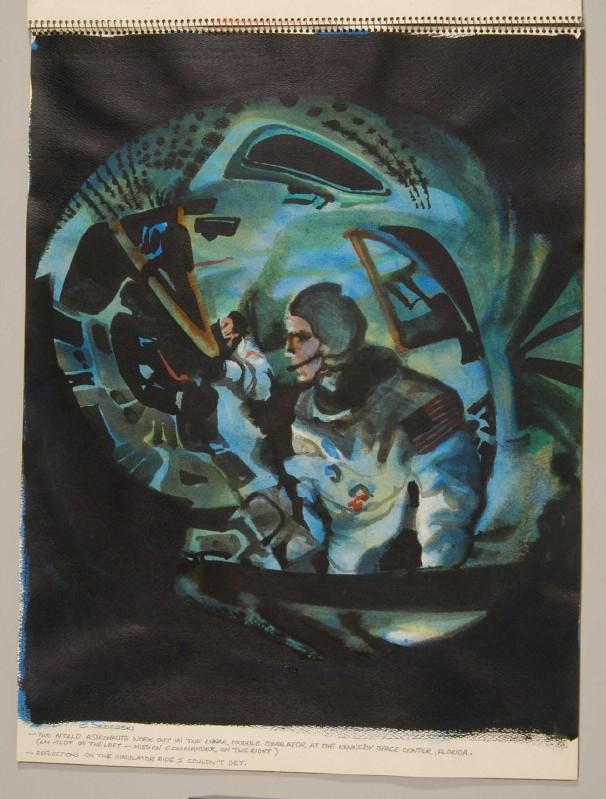
Two Apollo Astronauts in the LM Simulator, K.S.C.
(ink on paper) 1972 by Chet Jezierski
"A page from a spiral-bound sketchbook. The forms of two astronauts inside the lunar module simulator at Kennedy Space Center are framed by a circular background blend of blues and greens. The control panel is on the left side in darker shades, and the entire depiction is framed in black. Text in the bottom margin reads: 'Two Apollo astronauts work out in the Lunar Module Simulator at the Kennedy Space Center, Florida. (LM pilot on the left - mission commander on the right ) Reflections on the simulator ride I couldn't get.' "
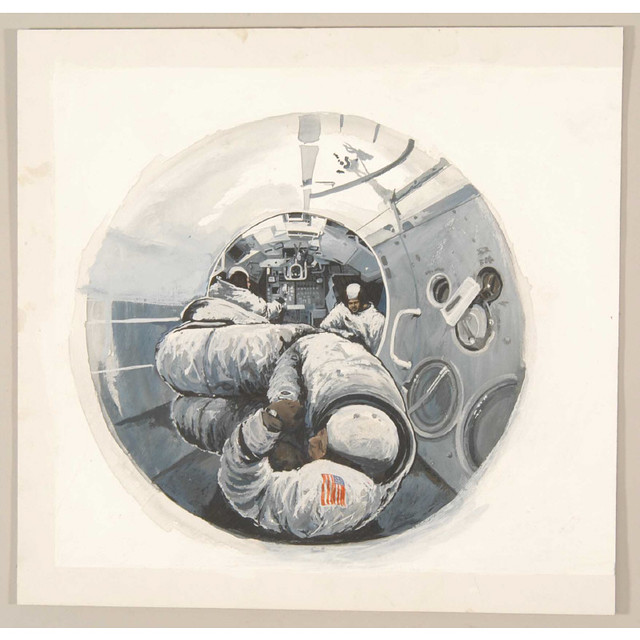
Untitled
(gouache on board) 1970 by Joseph Christopher Chizanskos
"Three astronauts inside the Apollo XIII"

Gordon and Conrad in Gemini Simulator
(ink + watercolour on paper) n.d. by Chrystal Jackson
A few photos from NASA Images.

Untitled
(conté crayon on paper) 1972 by Tom O'Hara
Apollo XVI astronauts collecting lunar rock specimens in April 1972

CM Boilerplate Lifted
(watercolour on paper) 1972 by Chet Jezierski
"The command module (CM) boilerplate looks like a showerhead with water pouring from it as it is lifted from the ocean water after splashdown. The structure looks as if it is suspended alone in a void of sky and water that are darkened by the night. The yellow-orange ring around the base is the flotation collar. The water appears grayish as it blends with the blues, greens, and browns of the sky."

Waiting to Sight the Descent of Apollo 11
(ink + charcoal on paper) 1969 by Mitchell Jamieson
"Waiting to sight the descent of Apollo 11 morning of July 24, 1969. A pilot is standing on the deck looking up towards the sky. A row of more ambiguously depicted men behind him. Pilot and men form a 'T'-shaped composition."
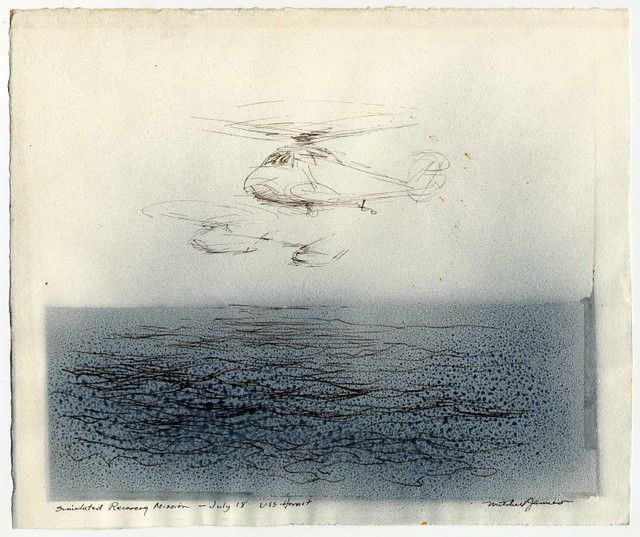
Simulated Recovery Mission
(pen, ink + airbrushed ink on paper) 1969 by Mitchell Jamieson
"Two helicopters flying over a light blue ocean. The helicopters are done in light, quick lines that help give the forms a sense of motion. The ocean has the fine blue mist from an air brush with larger blue spots and linear waves."
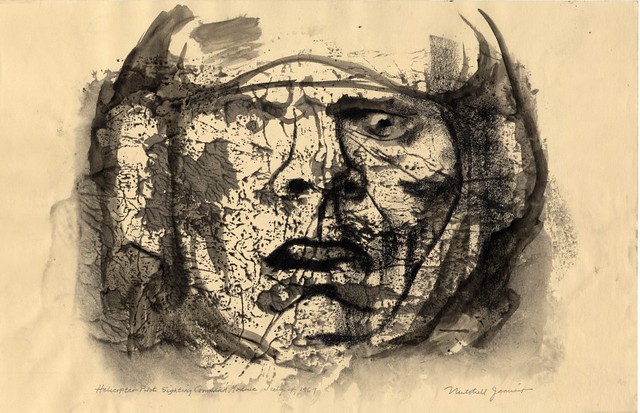
Heli Pilot Sighting CM
(charcoal + ink on paper) 1969 by Mitchell Jamieson
"Life-size drawing of face of a pilot with a tense expression. Face was drawn on top of textured surface done by mono-printing. Black ink and charcoal on beige paper. Apollo 11 mission."

Rain approaches Just Before 004 is Lowered
(watercolour + felt-tip pen on paper) 1972 by Chet Jezierski
"The helicopter is positioned on a slight diagonal at the bottom of the scene with its nose pointed to the left. It seems to visually melt into the superstructure of the USS Ticonderoga that rises in the center, thus giving the entire scene a triangular composition. The helicopter and ship are grey, with some yellow and red accents on the aircraft, and the sky is a blend of blue and white. The lower right corner is unpainted, appearing unfinished. Writing in the upper right reads: 'Apollo 17 USS Ticonderoga 13 Dec 72.' "
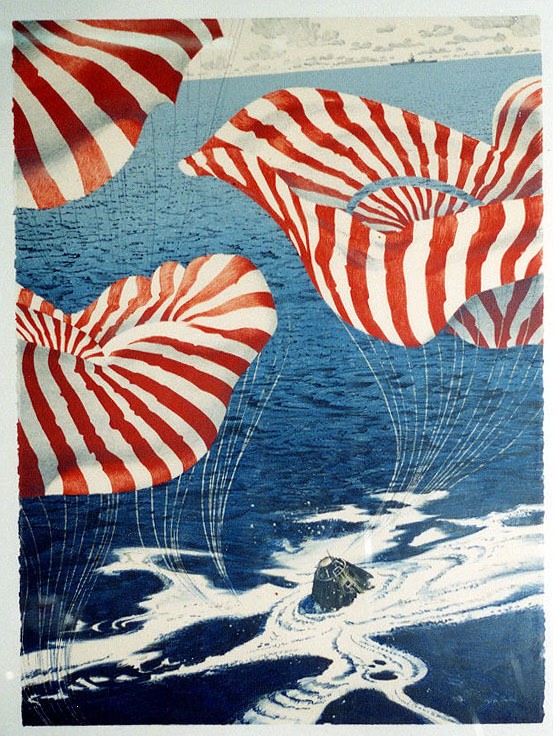
Splashdown
(lithograph) 1977 by Robert T McCall
"Three red and white striped parachutes dominate the scene and contrast with the blue ocean below. In the lower third of the scene is the command module surrounded by white ocean foam. In the distance on the horizon is a recovery ship."
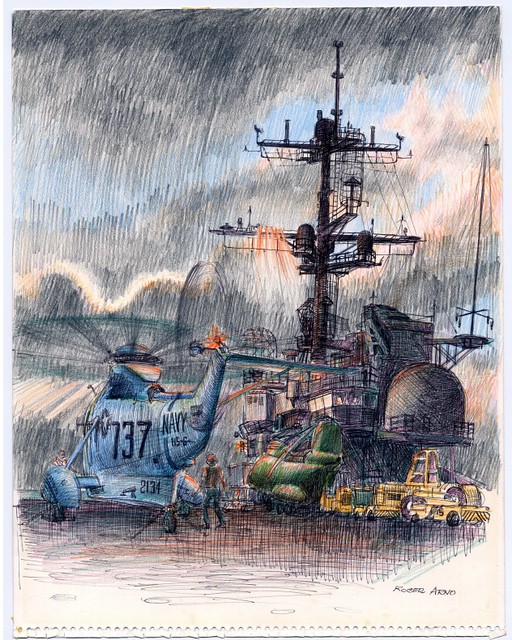
Untitled
(pencil + pen on paper) n.d. by Roger Arno
"Apollo-Soyuz Test Project recovery."
The Flight of Apollo-Soyuz from NASA History.
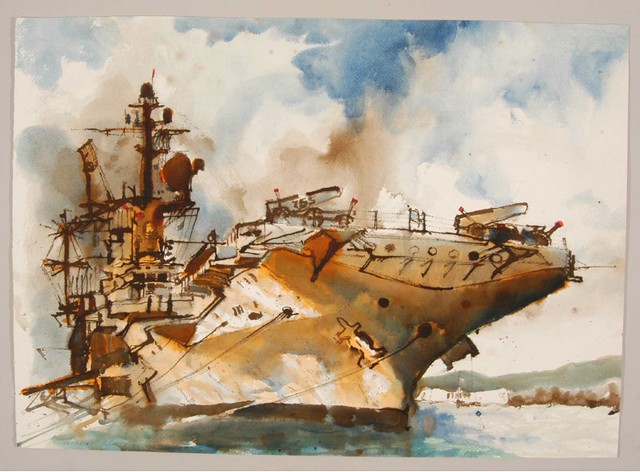
The Tyco Tiger
(Watercolor on Paper) 1972 by Chet Jezierski
"A frontal view of the side of the USS Ticonderoga shows this prime recovery ship as it sits in Pearl Harbor the day before leaving to rendezvous with Apollo 17. The flight deck looms forward like a big cliff while the superstructure of the carrier is shown on the left. The ship is shaded in orange and brown, which contrasts with the blue and white cloudy sky and the blue-green water. A glimpse of the coastline is visible on the lower right."
- There are over 1700 sketches, paintings and prints in NASA's Eyewitness to Space Collection. Those artworks are found among the object collections at the Smithsonian's National Air and Space Museum. [via things]
- Stars in Their Eyes - the NASA Art Collection : frieze mag review by Tom Morton (2003)
- Viewpoint: The Bigger Pictures By Piers Bizony, 2009.
- Fifty Years of NASA Art by Jeff Foust (2011) at The Space Review.
- NASA and the Arts by Bert Ulrich. (at NASA's 50th birthday site - 2008)
- Space Exploration - the greatest quotes.
It's worth looking through the whole collection. It becomes oddly meditative, or maybe mesmerizing, after the first few hundred or so artworks. Truly remarkable.



















7 comments :
This post is fucking fascinating; and I had no idea! Wonderful.
I agree! What a great post and great images! I'm going to disagree with Michael Collins, though. A priest isn't going to increase anyone's understanding about space. Confirm ancient superstitions, yes. Twist reality to support ancient superstitions, yes. Increase understanding, no.
I also suspect that Leonardo might have felt differently about flight if he had gotten motion sickness, but that's just me being overly literal!
Thanks again for a fantastic post!! I love your blog
Really enjoyed this!
Great post. I had no idea about the Eyewitness to Space program.
I love the pieces by Chet Jezierski, whom I'd never heard of before. And the drawings of the NASA Crawler Transporter are wonderful.
I like Michael Collins quite a bit. He made Ron Howard's Shadow of the Moon documentary so entertaining.
Collins' book Carrying the Fire should, in my opinion, be the book people think of when they think of space travel history. Not Wolfe's The Right Stuff.
Fantastic post.
i had the pleasure of seeing many of these and other jaw-dropping art the summer that the Air and Space Museum opened, in 1976 (it was 1976, wasn't it? I'm getting to that point in life where all the dates and years run together.)
The point being--I've never forgotten what it was like to stand before and absorb so many varied and marvelous depictions of human's relation to space. For a 15 year-old space junkie, it was a slice of heaven.
I love your blog for your knack of finding fascinating images I never would have thought even existed from sources I didn't know about of subjects which have universal appeal. You are truly a remarkable researcher and archive hunter, and it's clear from your blog it's something you love doing.
Thanks all. I really had no idea how amazing this stuff would be. I was actually fascinated by my own reactions while idly paging through the whole collection. As I said above, it's just mesmerizing. I can't think of m/any sets that are singularly thematic, huge in size and created by a big bunch of people: it's hypnotic after a while and starts becoming as much about us and the way we see and interpret as much as it has to do with the overt subject matter. That was a really (nicely) odd feeling.
And yeah, I can't imagine this kind of state-sponsored endeavour happening many places these days. It's a shame the propaganda-du-jour for a lot of the world is that governments are totally bad phenomenons to be avoided at all costs. *sigh*
Post a Comment
Comments are all moderated so don't waste your time spamming: they will never show up.
If you include ANY links that aren't pertinent to the blog post or discussion they will be deleted and a rash will break out in your underwear.
Also: please play the ball and not the person.
Note: only a member of this blog may post a comment.